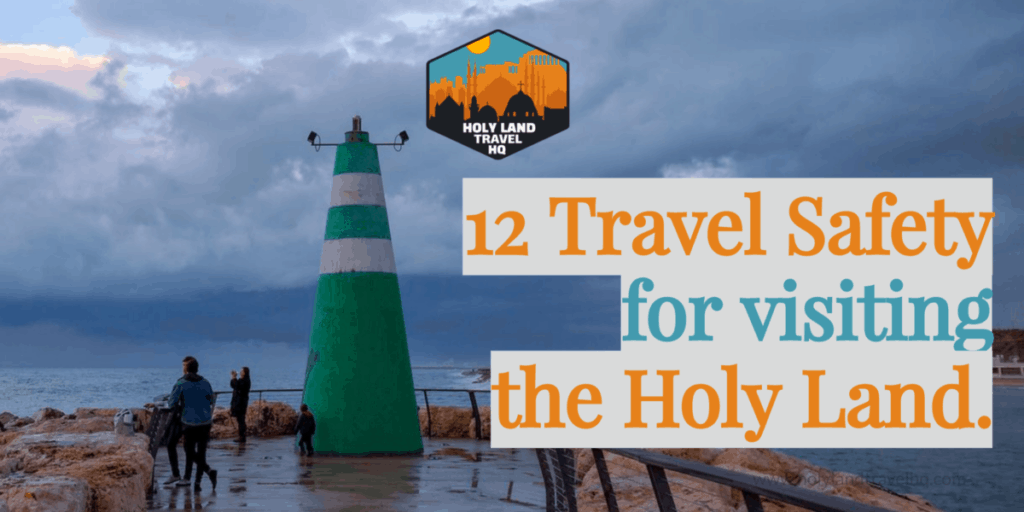
Any trip, even to grandma’s house, can conjure up anxiety about preparedness. Did you remember the casserole? Did you remember to pack your running shoes? Do you have extra copies of the report? What’s traffic look like? Should you wait?
Traveling abroad can present more challenges though, namely safety.
Today, I’m going to give you 12 travel safety tips to help you prepare for your trip.
- Keep your head up and eyes moving.
- Check behind you every so often.
- How to check your back with a group
- Set a perimeter with others when you stop.
- Develop a habit of awareness
- Be suspicious. But no weird.
- Maintain two points of contact on your personal belongings.
- Don’t’ wave your money around.
- Pack your day bag efficiently.
- Secure your gear.
- What you need to know about pockets.
- Choosing your shoes.
If you walk or drive around your own town, you’d most likely know where all the bad spots are. And how to deal with surprises. But you won’t be at home in the Holy Land.
In a previous post, I discussed safety concerns for Israel. In that post, I identified the biggest threat you will encounter, which is petty crime. In this post, we’re going to talk about how to navigate those situations with confidence.
Our goal is to reduce your signature and be less of a target. It’s about deterrence. We can never completely eradicate the threats around us, but we can make them think twice. This is called deterrence.
Deterrence is fostered by a mindset of awareness and established with a physical posture of attentiveness.
So, let’s get started.
As always, all links are direct.
1. Keep your head up and eyes moving.
Bad actors, or those looking to harm you or engage in nefarious activity, will always monitor a target before they act. It could be a few seconds, a few minutes, or even a couple of days.
Either way, a predator is going to observe their prey for vulnerabilities and weak spots. In the game of petty crime, a predator has plenty of targets to choose from. They will quickly spot and asses. Any sign of difficulty and they will move on.
The single most important aspect of your posture that will present difficulty to a threat is your awareness. You can accomplish this by keeping your head up and eyes moving.
If you were to look straight you could say you have 180 degrees of visibility. What you really have is about 90 degrees of focused visibility. With your peripheral vision, what you see on the outer edges of your point of view, you add unfocussed visibility. This brings your total field of view to about 180 degrees.
As you walk about a market or crowded area, turn your head often to shift that 90 degrees of focused visibility. In the process, your peripheral vision can identify objects and notify your brain of things that need attention.
It’s also very important that you make eye contact with people. It lets them know you are aware of them. Even if they don’t look back at you, you still need to look at them. Predators rely on the fact that you are unaware of their presence.
In addition to eye contact, you want to check what we in the military call 5s and 25s. Check your surroundings within 5 yards, and then check your surroundings out to 25 yards.
2. Check behind you every so often.
No one has eyes in the back of their head. Not even your mother, despite what she may tell you. When someone is looking to target you, this is the area where they will come from.
Also, if you lack awareness of things in front of you, it makes it even easier for predators to come from behind.
Keeping your head up and your eyes moving will give off the impression that you are aware of your surroundings, but you also need to watch your back. There are a couple of different ways to do this.
The first is to simply turn and look over your shoulder every so often. You can do this overtly by turning your upper body about 45 degrees and swinging your head to look over your shoulder.
The problem with this method is that it makes you look like a “fidgety CIA agent” being followed. It can make you look suspicious.
A more natural way to check your back is to stop at a shop every so often. Turn your body to face the storefront and take a look over your shoulder. You can mask your intention by making it look like you are just getting out of people’s way.
In general, if you make it your goal to not hinder someone else’s path, you will force yourself to be aware. And that, in turn, will send red flags to a predator.
The second way to check your back is to look when you turn a corner. This looks far less sketchy than the “fidgety CIA agent” look noted above. It can also be easily passed off as you just trying to stay out of other people’s paths.
3. How to check your back with a group.
Group security is much easier to do than on your own. Unless, of course, you are playing the game but others are not. There’s nothing worse than traveling with someone, or multiple people, who are oblivious to their surroundings.
These are the people who stop at a shop to look at a souvenir without recognizing the crowd they just blocked. Or the people who look down at the ground the whole time. Or those who break off from the group without telling anyone.
Part of the reason why I have a natural habit of looking over my shoulder when I turn a corner isn’t due to a habit of awareness. It’s because I’ve traveled with groups a lot. It’s amazing how often people just drop off to look at something. Then you have to backtrack and when you find the missing person, they have no idea the group left them.
While walking with a group, keep your head up. Look around as you did by yourself. But this time you can use each other when looking over your shoulder. When you talk, look your buddy in the eye momentarily, then take a glance over your shoulder, and then theirs. Make eye contact again, then repeat.
If you are the type of person that has a habit of doing headcounts, then be that person. If you aren’t, then constantly remind yourself that the group is relying on you to stay in sight. If you want to break off, tell someone.
Groups are also easy to identify when they stay together and communicate well. And predators don’t like messing with a group. Even in the animal kingdom a lion will go after a loner and avoid the group. Or they will stalk a group until a loner breaks off.
4. Set a perimeter with others when you stop.
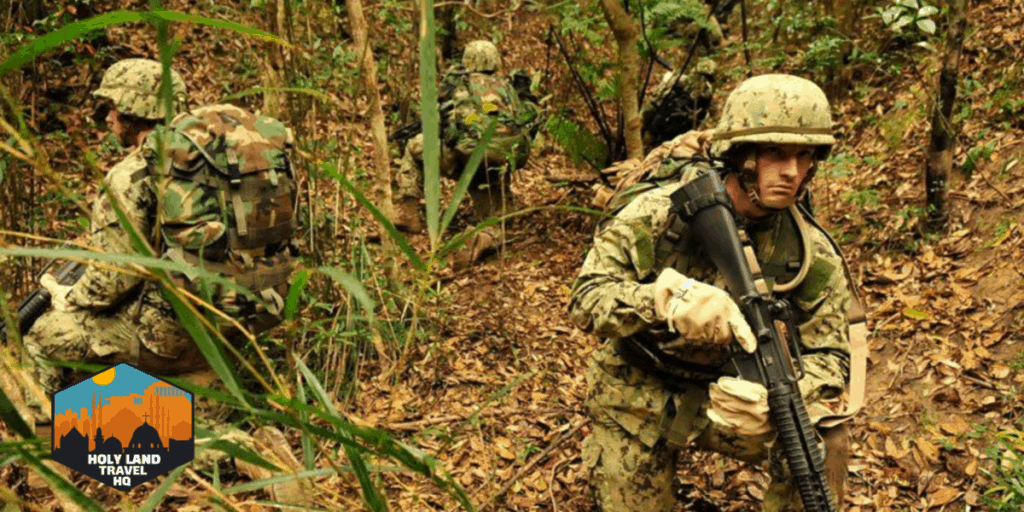
When a military patrol stops for any reason, they set a perimeter. They get in a circle and face outwards. Because they are looking outward in all directions, each individual can count on the team having their back.
The same concept can be used when traveling with a group. Whether it’s two people or more, you can use each other to watch your back. But not in a circle like a military patrol.
If you are talking, such as discussing the purchase of a souvenir, don’t stand side by side. Face each other. Make eye contact sparingly. Instead, look over each other’s shoulders. With two people on the lookout, you don’t need to watch your own back. Someone else has it covered.
5. Develop a habit of awareness
I discussed keeping your head up and your eyes moving. This shows awareness, but what are you looking at?
You want to shift between eye contact with others and the physical environment. Are there any exits ahead? What exits did you pass that you could use if needed?
Are there any identifiable landmarks you can use as a reference in case you get lost? These references can be a flashy storefront, or a coke machine standing by itself. Or a unique coffee shop.
What is the surface of the pathway made of? Are there steps? If so, do the steps have wheelchair aids?
Are there any direction signs? Any cubbyholes that seem to always have someone in them? What’s the deal with that guy smoking the cigarette by the corner all the time?
What’s the name of the purse shop around the corner from the antique shop?
For some people being self-aware and group-aware is easy. For others, it’s a new skill that needs to be learned.
A simple way to develop a habit of awareness is to walk around your hometown or go for a drive. Go with your spouse or another group member. Call out business signs, street signs, road obstructions, and the fact that Homeless Joe moved again. Take note of things that have changed.
Take note of colors. Words. The type of material certain things are made of.
Also, take note of things that seem out of place. It’s 5 pm, and 5th avenue is empty. Why? You’ve seen a cop pull someone over at the same intersection 3 times now. Where does he hide and what is the infraction?
6. Be suspicious. But not weird.
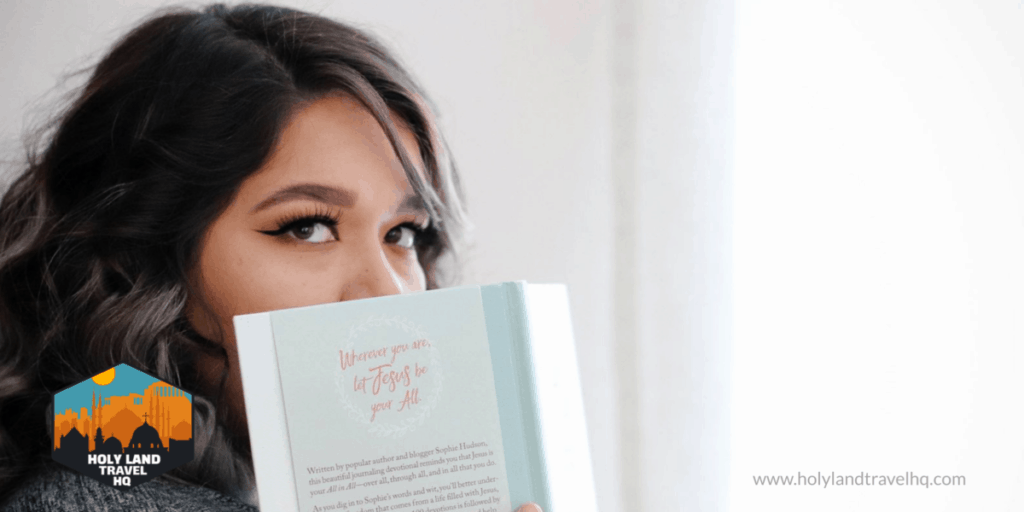
As you walk about, it’s always good to have a modicum of suspicion about everything. Most people are kind-hearted and genuine. But don’t get too trusting. They aren’t the ones you’re concerned about.
You need to be comfortable with the idea that a small portion of every society has bad apples. And there are always those in the group who don’t understand why bad apples do bad things.
As a result, there are those that believe all the security information is overhyped propaganda. If you show people trust they will respond with kindness.
Then there are those in the group who hear the dangers of traveling and assume everyone is a threat. They trust no one and the slightest infraction of that trust is nefarious to them.
I believe both of those attitudes are dangerous. Especially in a group. The person with the lackadaisical attitude tends to not look out for others. The person with an overly cautious attitude brings anxiety into the group. Both are inherently selfish.
An attitude of suspicion is one in which you actively assess and decide what to monitor and what not to.
You see a group of young boys running through the market. Are they picking pockets? They have a ball and they’re laughing. Probably not, they’re too loud and noticeable.
The merchant selling antiquities has some artifacts on sale. His dealer certificate is posted. However, he insists on wrapping your item in the back room. Maybe you should ask more questions about the item’s origin.
You’re in the Church of the Holy Sepulchre and you crawl into the room near the Edicule with the tombs. You turn around and two boys are blocking the entrance, asking for money. They are definitely up to no good. Stay calm, firmly tell them to leave.
7. Maintain two points of contact on your personal belongings.

If you’re carrying a backpack, sling both straps over your shoulders. When you take it off, firmly grab the strap you are not removing. Reach around with your other hand and grab the bag as you swing it in front of you.
A good way to maintain control of a backpack while opening it up is to sling it on your chest like you sling it on your back.
If you have a handbag, purse, or shoulder bag. Sling the strap across your body not just your shoulder. Place your hand at the base of the strap, where it connects to the bag.
This advice goes for cameras as well. Yes, I get it, it’s annoying to sling your camera across your body. But it’s worth the effort. These days there are tons of third-party camera straps designed for cross body setups.
If you pull your smartphone out, wrap a hand around it tightly until you can get two hands on it.
Also, most people hold their phones between their thumbs and index fingers. When taking pictures, they often loosely hold on.
Hands come in all sizes, so it’s hard to give a solid recommendation on handholds here. What you want to aim for is coverage on all four edges of the device.
When someone looks to snatch a device, they are going to grab an open area on the device. If the victim’s finger or hand is in the way, it may interfere with the transition. So, maintain full coverage with a tight grip.
For point-and-shoot cameras that come with a wrist strap, use the wrist strap. It’s not much, but it might be enough to stop a would-be thief.
8. Don’t’ wave your money around.

In both the Old City and Yehuda Markets, some of the shops are more like lockers. All the products are right there and transactions are done on the spot. Other shops have deep spaces you can enter.
Where ever you may be, always pay attention to your surroundings. It’s like crossing the road, look both ways before pulling your wallet out.
One of the things I’ve noticed is that people in groups will all look at the wallet and money. No one looks outward.
So, if you are in a group, talk about it before you enter the market. When someone goes to buy something, everyone else needs to focus their eyes outward, not inward towards the money.
If there are plenty of group members around, sometimes it is good to get a second set of eyes on the transaction. And ears.
Another tip is to have a travel wallet. This is a wallet that has some kind of lanyard or strap that attaches to you somehow. Whether it be your belt or waist.
Stay away from necklace money pouches. They dangle in front of you and often have really poor straps.
One set up I’ve used was a beltline wallet in which I kept my credit cards and cash. I kept it hidden under my belt and pants. I then had a small palm-sized wallet I kept in my back, zippered pocket. I would transfer small amounts of money to it when I was on the bus.
Another setup I’ve used was a pouch wallet that was attached to my belt. It hung inside my pants. The wallet was well hidden from pickpockets, but it was also annoying for me to retrieve sometimes. I liked it more than the first setup though.
9. Pack your day bag efficiently.
One of the habits I learned in the military was organizing my gear. For some gear the organization was standardized. For others, it was up to me. The purpose of organization is to facilitate efficiency and quick access under pressure or urgent need.
As a traveler, you won’t be under the same kind of pressure, but you will want to be organized.
When you are out and about, you don’t want to unload your entire bag to find something. It’s a waste of time, and it also opens you up to being a target.
Your camera battery power light pops on and now you can’t find the spare. Or you need your passport. It was in the pile of stuff that you threw into the bag this morning, it has to be in there. Meanwhile, the security officer and everyone on the bus are waiting for you.
Making sure your bag is organized will also aid you in accounting for everything you need for the day. As well as knowing where you placed it.
10. Secure your gear.
You’ve packed your bag, now you need to secure it. This is different than organizing though.
Securing your gear refers to things like buckling all your strap buckles. Zipping all the bag’s compartments closed. Tying down externally mounted gear. And so forth.
There is a method to the madness though.
Most shoulder bags, handbags, and purses have a single zipper slider. So, you will want to make sure it is closed all the way. Backpacks, however, usually have 2 zipper sliders. Never close the zipper so that the sliders meet in the middle.
The reason for zipping a compartment closed to one side is that zippers can easily come undone. I learned this the hard way.
Something heavy in a more outward compartment can pull at the apex of the zipper. So can gear attached to the outside of the bag. Or bulky items in the compartment can shift and push the zipper open. When both sliders are zipped to one side it’s difficult for these forces to pry the zipper open.
Zipping to one side also makes it difficult for someone to get into the bag on the fly. Whereas, a backpack with the zipper sliders in the middle is rather easy. All someone needs to do is pull on the bag near the zipper apex.
Any gear mounted on the outside of the bag, such as a water bottle, should be secured as well. Looping a strap around or through a handle will accomplish this.
A bag’s straps were made for a reason. So, use them. They aren’t there to hold your bag together when it’s overstuffed. Their purpose is to compress the bag to avoid shifting contents and keep compartments from unzipping.
Also, avoid mounting valuables on the outside of your bag.
11. What you need to know about pockets
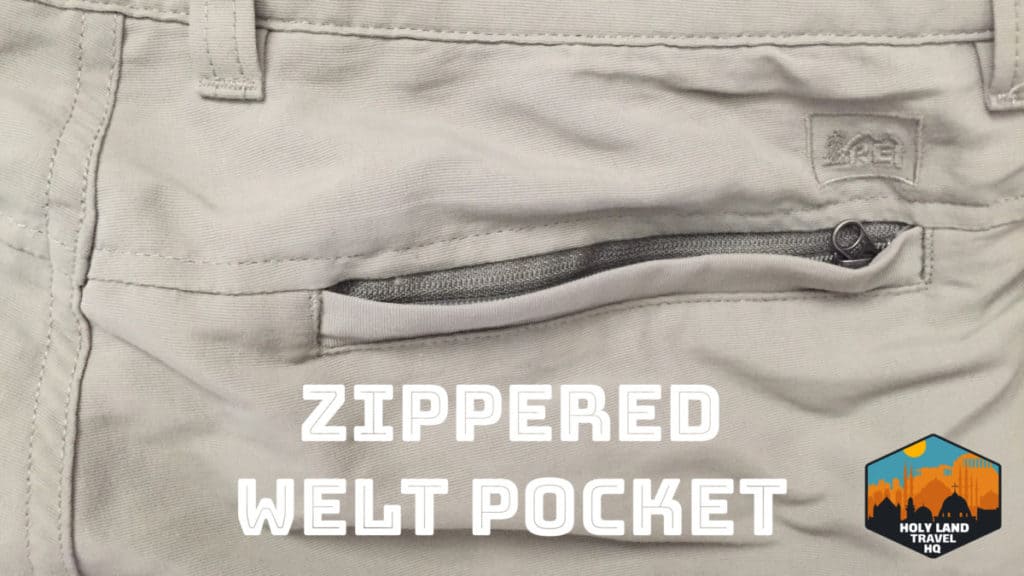
You’re probably wondering, what you’re missing when it comes to pockets and zippers. My guess is that you already know, it just hasn’t been brought up.
If you’re anything like me you’ve had things fall out of a pocket you thought was secure. I’ve had things wriggle their way out of pockets closed with Velcro and buttons just as easily as open pockets. I have not had anything slip out of a zippered pocket yet.
The discussion here mainly focuses on pants, but it also applies to bags.
When you choose what pants, shorts, skirt, or dress to wear on your trip, take into account the pockets.
Are they patch pockets, gusset pockets, or welt pockets?
Patch pockets and gusset pockets tend to hang open when not secured with a flap. A flap secured with Velcro can get in the way when you attempt to insert your wallet into the pocket. A buttoned flap can be so annoying you don’t secure the buttons and that’s when you lose something.
Ideally, you want a garment with zippered welt pocket and no flaps. I wrote a whole post on pockets and zippers, which you can find right here. Check it out for a more in-depth discussion on this topic.
If you like cargo pockets go for it. I don’t like them because they are the easiest pockets to lose things from. And they are annoying when filled.
You need to practice inserting and retrieving your wallet from the pocket. It needs to be quick.
Place your wallet deep in the fold of your hand. Fingers fully extended with your thumb pinching it.
The tips of your fingers should extend past the end of your wallet. Use your fingertips, not the wallet, to open the pocket.
12. Choosing your shoes
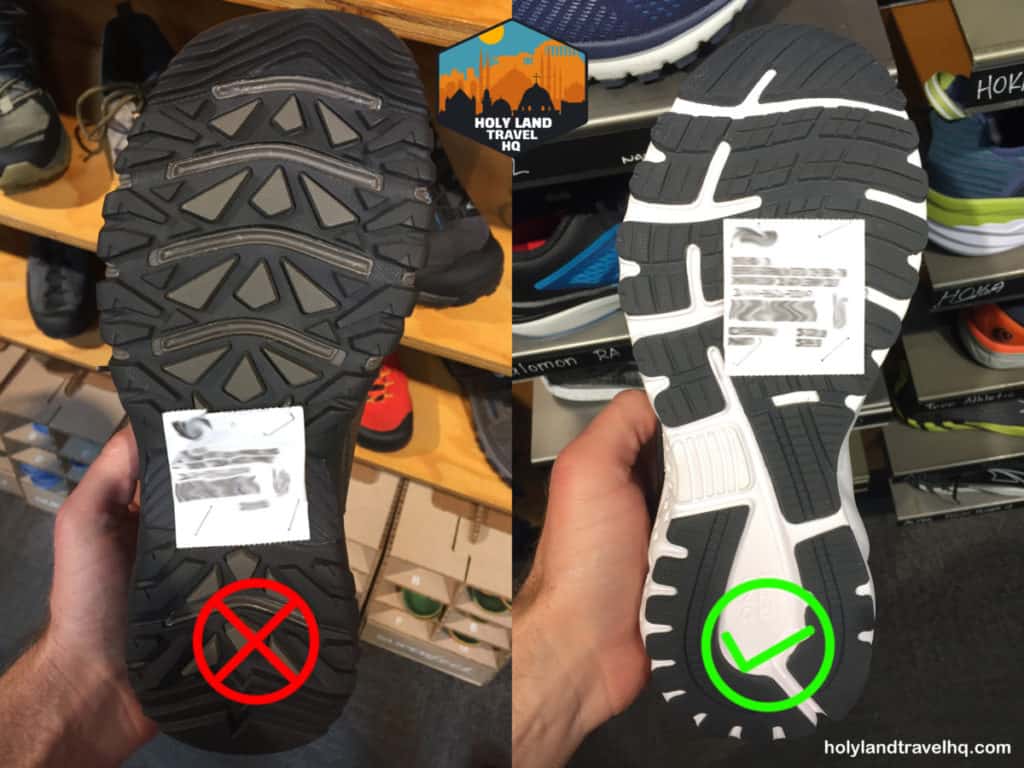
So far all of the tips on this list have been geared towards safeguarding against petty crime. What you put on your feet is going to be the most important item on your list regarding your physical safety.
On your tour, you will experience a variety of walking surfaces. Concrete, asphalt, pave stones, hard-packed dirt, grass, and a few others.
Most tours are designed to accommodate all ages, including older tourists. There are a few that will include hikes where you will encounter loose dirt. But this is not the norm.
What this means is that you can expect surfaces to be generally flat, with some warping due to age. You will also encounter steps, often made of smooth stone. In Jerusalem, you will encounter a few paved inclines and declines. Particularly around the Mount of Olives, the Southern Steps, the City of David, and the Kidron Valley.
Smooth surfaces will get slippery when covered with dust or rain. This goes for hardpacked dirt just as much as stone pavers. In fact, many of the stones in the Old City are extremely smooth after centuries of foot traffic. They don’t even need dust or condensation to be slippery.
Roots and rocks pop up in hard-packed dirt all the time and present themselves as trip hazards.
In addition to this, you will be on your feet a lot.
Designer shoes and sandals typically have no traction to deal with the array of surfaces noted above. And hiking shoes have hard nubs designed to deal with loose dirt, not hard surfaces.
The best shoes for your trip are running or walking shoes.
For a more comprehensive discussion on choosing your shoes, check out my post on the topic right here.


